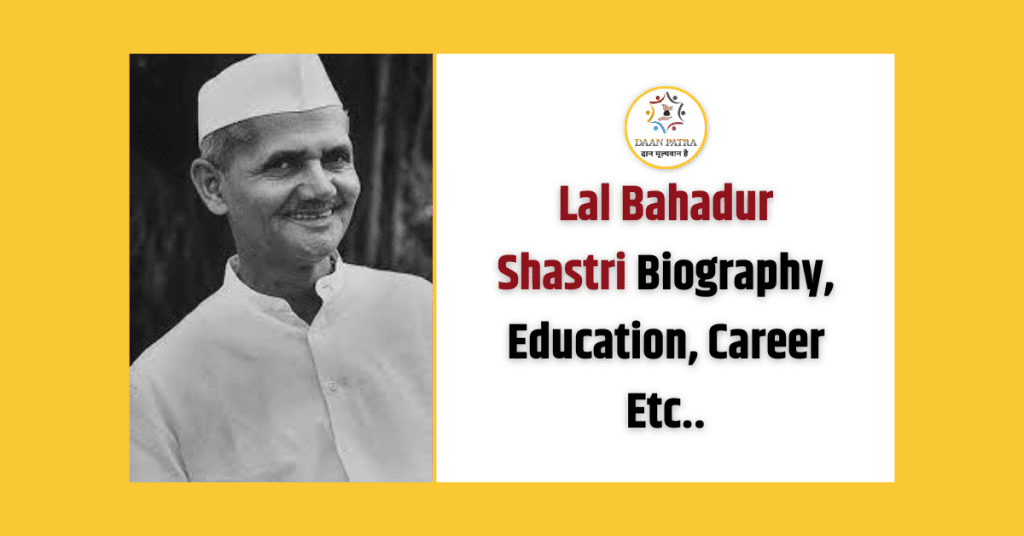India’s second Prime Minister, Lal Bahadur Shastri, was a humble leader known for his integrity and simplicity. From humble beginnings, he rose to prominence during the Indo-Pakistan War of 1965, coining the iconic slogan “Jai Jawan Jai Kisan” to honour both soldiers and farmers. Shastri’s dedication to social justice, as well as his untimely death in 1966, have left an indelible mark on Indian political history.
Lal Bahadur Shastri Biography
Lal Bahadur Shastri was India’s second prime minister and nobody can forget his contribution and dedication to India. His contribution to power made such a significant impact on our nation that we celebrate his birthday as “Lal Bahadur Shastri Jayanti” to give him honour every single year.
Take this article as a form of Lal Bahadur Shastri Biography, because we will be talking about Shastri Ji’s early days as a freedom fighter to his crucial part in determining India’s fate. Hence make sure you read the entire article till the end to gain true and full knowledge about Shastri Ji’s work and contribution.
Why We Celebrate Lal Bahadur Shastri Jayanti
On October 2, India celebrates Lal Bahadur Shastri’s birthday which is popularly known as “Lal Bahadur Shastri Jayanti” by many. This humble leader came from a small town to lead the country through difficult times like the 1965 Indo-Pakistani War. “Jai Jawan Jai Kisan” (triumph to the military, triumph to the farmer) became the nation’s motto and reflected the desire for an independent India. Even though Shastri’s service in government was limited, his legacy of integrity, humility, and unrelenting dedication is an inspiration to this day.
Lal Bahadur Shastri’s Family
Shastri ji’s mother reared him and his sisters with the assistance of her father when his father passed away when he was still a toddler. Shastri overcame obstacles to acquire valuable lessons like bravery, patience, and kindness during his early years.
In Varanasi, Lal Bahadur Shastri education was done, and was married to Lalita Devi in 1928. He only accepted a modest quantity of handwoven cloth as a present since he thought that marriage shouldn’t involve unfair payments (dowry). Together, Shastri and Lalita had six children.
Achievements of Lal Bahadur Shastri
Lal Bahadur Shastri childhood was drawn to the struggle for Indian freedom. His passion was inspired by writings by Marx, Russell, and Lenin as well as stories of national leaders. Mahatma Gandhi’s 1915 statement sealed his destiny to join the independence cause. His education was reduced to this noble goal.
Lal Bahadur was first taken into custody in 1921 after disobeying a British directive. The authorities had to free him because he was still a teenager. He continued after that. He encouraged people to boycott taxes and join Gandhi’s “Salt March” against British oppression in his capacity as a leader of the local Congress party. This resulted in another prison time in 1942, during which he read motivational works on philosophy and social revolution.
At last, Lal Bahadur’s perseverance paid off in 1937. He made significant progress toward realizing his goal of a free India when he was elected to the state assembly.
Click here to Donate Online to help Child Education NGO
Lal Bahadur Shastri’s Political Career
Lal Bahadur Shastri held important posts in government after India’s independence. When he was Uttar Pradesh’s minister of police, he introduced fresh concepts such as crowd control with water pistols rather than weapons. Prime Minister Nehru was impressed by Shastri’s dedication to change and asked him to become the Minister of Railways in his cabinet. Shastri was renowned for honesty and morality.
On the other hand, a rail disaster in Ariyalur in 1956 brutally claimed 150 lives. Shastri accepted responsibility and resigned from his position after being emotionally touched by the tragic event. Nehru expressed his admiration for Shastri’s moral character and commitment to his beliefs even after this setback, stating, “There’s no better comrade than Lal Bahadur, a man of the highest honesty and committed to his ideals.”
Lal Bahadur Shastri did not take a long vacation following his resignation. He rejoined the administration in 1957 and took on a variety of tasks. First, in his position as Minister of Transport and Communications, he succeeded in getting people and things operating smoothly. As the Minister of Commerce and Industry, he then changed the focus to focusing on India’s commerce and industry.
Shastri gained an important position as the Home Minister in 1961. One of his main goals was to take on corruption directly. He established the “Committee on Prevention of Corruption,” which is chaired by K. Santhanam, to address this chronic issue and guarantee justice and integrity in India’s government.
Lal Bahadur Shastri As Prime Minister of India
In 1964, Lal Bahadur Shastri took over unexpectedly as Prime Minister after the death of Nehru. Shastri refused to give up in the face of difficult issues like poverty, unemployment, and hunger. He asked experts to come up with a plan since he realized that India needed a long-term solution to its food problems. This resulted in the well-known “Green Revolution,” which revolutionized farming and increased food output.
He understood that everyone needed milk, protein, and wholesome food. To strengthen India’s dairy industry, he spearheaded the “White Revolution” for this reason. In an attempt to support dairy farmers and provide access to milk for everyone, he even founded the National Dairy Development Board in 1965.
Lal Bahadur Shastri’s achievements gained popularity because of his controlled leadership and commitment to finding simple solutions. Although he was a humble politician, his deeds spoke volumes and helped countless Indians have a better future.
In 1965, Pakistan launched another attack on India, which was still recovering from the Chinese invasion of 1962. Shastri ji said that India would not watch helplessly and that our brave warriors would be allowed to defend themselves. He made it quite plain what he was saying: “If attacked, we will fight back.”
The UN called for an agreement on September 23, but the war went on till then. Shastri ji agreed to negotiations with Pakistan, supported by the Russian Prime Minister, recognizing the necessity for peace. The battle came to an official end on January 10, 1966, when Shastri ji and his Pakistani counterpart signed the Tashkent Declaration.
Shastri Ji exhibited his determination and loyalty to India’s safety through his leadership during this trying time. He recognized the value of maintaining national security as well as achieving diplomatic peace.
Lal Bahadur Shastri Death
On January 11, 1966, Lal Bahadur Shastri, who had previously suffered two heart attacks, died from a third. He was in Tashkent, Uzbekistan, when he signed the Tashkent Pact with Pakistan for the end of the Indo-Pak War. He was the only Indian prime minister to die overseas, and sadly, this was his last international tour.
It makes sense that Shastri’s sudden death prompted questions and rumours. His wife Lalita Devi raised doubts about possible conspiracy and accused him of poisoning and bringing up the subject of the prime minister being looked after by a Russian butler. However, the findings of an official investigation that included a medical examination showed that Shastri died of natural causes.
Conclusion
Official judgments are still preserved, despite frequent suspicions of conspiracy ideas. Although there have been a few media publications hinting about potential CIA involvement, concrete evidence has never surfaced. In 2016, author Anuj Dhar filed an RTI request seeking information regarding Shastri ji’s passing; however, the Prime Minister’s Office declined to reply, saying potential negative effects on diplomatic relations with the United States.
Yet, Lal Bahadur Shastri achievements and legacy remain unharmed by these unknowns. He is renowned for being a leader who bravely and kindly overcame hardship, leaving a legacy of honesty, determination, and loyalty to the nation. Generations will remember Lal Bahadur Shastri Biography which has been inspired by his contributions to India’s growth and his unshakable commitment to peace, despite his tragic and sudden death. Till eternity India will celebrate Lal Bahadur Shastri Jayanti to give respect and honor.
FAQs
Why is Lal Bahadur Shastri famous for?
Lal Bahadur Shastri is popularly known for his “Jai Jawan Jai Kisan” Quote which represented his goal of building a powerful and independent India. This also includes his important decision-making during the Indo-Pakistani War of 1965.
What was Lal Bahadur Shastri popularly known as?
Lal Bahadur Shastri was given several loving nicknames, each of which reflected something unique about his character and leadership. Among the well-known ones are:
- Man of Peace
- Jai Jawan Jai Kisan
- Shastriji
- Nanhe Nehru
Related Posts:
Importance & Benefits of Slum Education In India
Top 10 Advantages of Girl Child Education in India
10 Child Rights in India- A Comprehensive Guide


I have a great command of sophisticated language and literature because I am an artist at heart as well as a writer by profession. I am able to constantly produce work of a high quality because of my knowledge. I’m well-known for my versatility and am an excellent writer of both creative and technical content. To write content that is both entertaining and customized, I take the approach of getting to know the interests and preferences of my targeted audience.

